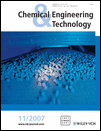Semibatch Production of Pharmaceutical Grade Magnesium Stearate: A Statistical Approach
Abstract
Fractional factorial design was employed to investigate the effect of feed composition and the major operating variables on the production of pharmaceutical grade magnesium stearate in a double decomposition process. The studied variables were initial stearic acid concentration, initial sodium hydroxide concentration, initial magnesium sulfate concentration, as well as reactor temperature at the time of NaOH addition (the first reaction temperature) and reactor temperature during magnesium sulfate addition (the final reaction temperature), pH of the solution at the end of reaction (final pH). The moisture content of the cake produced after filtration and the yield of magnesium stearate in the dried cake (assay), were the most important responses investigated as a function of feed and operating variables and these were optimized through statistical analysis. The results of the study showed that both magnesium sulfate and NaOH had high positive effects on the final pH, with a nonsignificant effect of the other main factors being observed. Increasing the NaOH concentration and the first reaction temperature led to an increase in the assay production, whereas the binary interaction of stearic acid and NaOH revealed a negative effect. The acid as well as NaOH concentrations exhibited positive influence on the moisture content of the filtered cake. Finally, the simplex optimization method was used to obtain the optimal conditions. The results of the study were successfully adapted to the large scale production of pharmaceutical grade magnesium stearate and pharmaceutical grade product was produced meeting the standards required.




